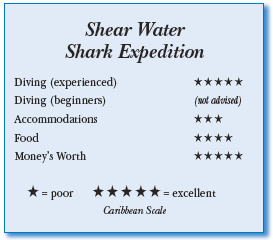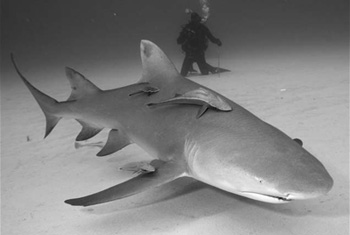MV Shear Water, The BahamasContents of this Issue: Excellent New Interactive Caribbean Fish Guide The Next “Best Destination in the World?” Shaking the Rust in Thumbs Up Cozumel Is Digital Imaging Photography? Part II Scubapro MK20 Cracking Problem Deepens When Your Checked Dive Bag Disappears: Shark Repellent Being Developed The ‘pee factor’ in diving: When the urge hits, should you? Editorial Office: Ben Davison Publisher and Editor Undercurrent 3020 Bridgeway, Suite 102 Sausalito, CA 94965 swimming with sharks from the August, 2005 issue of Undercurrent
Dear Fellow Divers, With constant reports of the decimation of the world's shark population by Asian fishing fleets, the opportunities for viewing large sharks underwater are becoming limited. So, when I was invited by friends to join them on a Bahamas "Shark Expedition" to dive with large tiger, lemon and reef sharks, I signed on immediately. It was a smart move, as I spent an exciting June week diving off the MV Shear Water with prime specimen sharks. No hotrod, macho, adrenalin pumping, feeding-frenzy shark diving with this operation. Jim Abernethy, the proprietor of Scuba Adventures (JASA) in West Palm Beach, FL, provides a measured scientific approach to viewing large sharks underwater. He attracts the big animals not by feeding them, but by placing "bait crates" in the water and letting the scent attract them naturally. His skill has led to charters by National Geographic Society and the IMAX team of Howard and Michelle Hall among others. Diving with Jim and his enthusiastic staff was fascinating.At one of Jim's "secret spots" in the northern Bahamas he calls Tiger Beach (strangely, not a beach or island within eyesight), we spent three days in shallow water photographing tiger sharks up to 14 feet long and lemon sharks that averaged 8 feet. I could often view up close and personal six tigers and eight or more lemons during each one-hour dive. I was struck by differences between the massive, slow-moving tiger sharks with their large dark eyes and the more active lemons, which looked much like the sharks in many of Gary Larson's cartoons. Jim's briefing on the sharks added a lot to my
knowledge. Learning that the tiger sharks we were seeing
could grow longer than the Great White added zest to the
dives. Jim's goal is to get the divers and sharks "as close as possible, for as long as possible -- safely." To do so requires that the sharks become comfortable with the divers -- of whom they are afraid. Divers are told to move slowly, avoid rapid finning and return to the boat slowly and cautiously. And no touching the animals. To begin the diving, Jim and one of his crew went down with bait crates and placed them on the sandy bottom at twenty feet. The crates, filled with frozen fish parts, were locked securely with cable ties. As the fish parts thawed, their scent traveled down current, eventually attracting the sharks. Divers arranged themselves ten feet apart in an open "V" down current. It is open water, with divers and sharks sharing space. Jim told us not to touch the bait and gave us a short PVC pipe to ward off a shark if one should attack. The "shark stick" is not used to touch, poke or provoke the shark. The sharks were usually fended off with cameras, but Jim mentioned that, strangely enough, during his trips there have been several incidents of sharks biting and taking away cameras, though they always dropped the cameras, which were later retrieved. Speculation is that the sharks are attracted by the electronic emissions. Jim never feeds the sharks. Only the scent attracts them. I've seen staged feeding frenzies in the Red Sea, Papua New Guinea, the Bahamas, and Indonesia. Sure they were exciting. But, they were conducted without any consideration of the long-term effect on the animals, which become conditioned to being fed by humans. The absence of feeding frenzies seems to make Jim's entire operation more under control. Also, in all those other operations, the sharks left when the bait was consumed; with Jim's method the sharks stay in the area. Also, Jim's secret spots were out of sight of land, which meant no tourists, swimmers, snorkelers and, of course, no fishermen. Captain Jim and his crew of Jake and Brian worked continuously, day and night, to get sharks and divers safely together. Jim, with his enthusiasm, good humor and boundless energy led the way for the crew, as it emulated his approach to providing guests with "the best trip of their lives." Jim and Brian are excellent professional photographers/videographers and were happy to provide tips and assistance, as was trip leader David Haas. There were usually two of the three in the water with us. Abernethy has his act together. I'll tell you about one diver who on the third day developed a nondiving illness. He called his doctor on his satellite phone and was told to go to a hospital in West Palm Beach and start on medication. Jim set up a Coast Guard evacuation that went off without a hitch. Half the guests were underwater as events transpired. A helicopter arrived, lowered a specialist in a harness, who then guided the "patient crate" that hauled the passenger up and away. When we arrived back at the marina on our last day, our diver was there to greet us, cheerful and healthy, but chagrined to learn of all the great shark shots he had missed. The Shear Water is a dive boat, not a luxury liner. At 65 feet she is compact, and despite a clever layout, guests, crew and gear took up all the room. The main salon has two tables that are (except at meal times) crammed with still and video cameras, housings, laptop computers, extra hard drives, cables, batteries, chargers, flash equipment, name it. Although most guests brought their own computers, the salon has a large-screen TV monitor and the necessary cables for viewing the day's handiwork. While bins and charging stations were at the rear of the salon, with the cooperation of the guests somehow it all worked. Below the main deck are three cabins with upper and lower bunks, ample under-bunk stowage space, adequate ventilation and reading lights. Forward there is what I call the "Vee Dormitory" - an area with three sets of upper and lower bunks. Because the shark expeditions take only ten divers rather than the twelve the ship can hold, the two extra bunks were used to stow gear. With little room aboard for bulky nonessentials, savvy travelers left their luggage and nonessentials at Jim's marina office. There were two heads shared by all, and plenty of hot water for the showers. The dive deck aft of the salon provides seats, gear bins, tank racks with aluminum 80s filled to 3,000 psi. By dividing divers into two groups, kitting up was easy among the clutter. To enter the water, walk to the twostep platform, step down and ease into the water to avoid shark-attracting splashing. To reboard, just swim up onto the first platform at water level, then push up to the next level. Hand your camera to the waiting crew member, then take off your fins and climb aboard, with ready assistance from the crew. Forward is a roomy bow area where the bait crates with frozen fish remains are stowed. Not my idea of a pleasure area for sunbathing. One thing to note: the Shear Water rolls heavily in rough water and during the all-night crossing of the Gulf Stream from Florida. Let me refer to you to the last issue of Undercurrent, July, to get tips about preventing mal de mer.
Chef Wade, a former U.S. Navy submarine cook, was a jolly soul who dished up volumes of tasty food. Cereal and toast were available with coffee and tea at 6:30 a.m., then at 8:00 a.m. came scrambled eggs, bacon, sausages, pancakes, toast, muffins. Lunches of tacos, hamburgers, chili, etc. in heaping portions were served cafeteria style. Dinners included roasts, chicken, potatoes, pasta, vegetables, etc., with complimentary wine. Then, nightly, a huge cake and ice cream. A hearty all-American menu prepared by a former Navy cook was just what shark divers needed. A soda-dispensing fountain provided soft drinks. One could request specific canned drinks to be stocked for the trip, but if you like beer or booze or a wine with an appellation, bring your own (if you have an hour or so in West Palm Beach, you can get your supply). Besides a Tiger Beach, Jim had other "secret spots" where he and his crew arranged some fine shark diving with visibility exceeding 100 feet. At Silverado we swam with large gray reef sharks and a beautiful mature hawksbill turtle. This site was pristine with breathtaking corals lacking the algae that has spoiled some recent Bahamian diving for me. Carcharhinus Reef was another prime spot for diving with those gray reef sharks. A splendid reef with multiple cracks and valleys, it offered (thanks again to those odiferous bait crates) dozens of reef sharks. I delighted in viewing a large school of southern sennet, big groupers and plenty of reef fish such as butterfly fish, parrot fish, angelfish, even schooling horse-eye jacks. Near the end of the trip, foul weather blew in from the Gulf, so we finished our week at Lizard Reef. Here were more of the usual Bahamas tropical fish with many colonies of yellow-headed jawfish. The only sign of man's intrusion was the barnacle-covered remains of a bicycle -- another Gary Larson cartoon? I missed the 12-foot tiger shark because I skipped the dive to be sure I was bubble- free for my early flight home the next day. I've met many folks in my thirty years of diving, but the divers on this trip were exceptional. Because Shark Expeditions are geared for experienced divers there were no newbies, no risk-taking thrill-seekers. Because of the shared interest in observing large sharks the camaraderie jelled from the first day. I observed no shark harassing, only serious photographers who were intent on underwater interactions with some of the largest fish in the ocean. There were several university types including a personable French macro-biologist, a successful financial type, a working policeman, and several businessmen. One particularly interesting chap was Lazaro Ruda, an avid nature lover. His web site www.TheLivingSea.com is an interesting tribute to the underwater world. Camera malfunctions were at a minimum -- usually a sign of a good dive week. I recognize that there is an element of danger being in the water with large sharks that have been identified as man-eaters, but Jim and his able crew have developed procedures that reduce the risk. I also recognize that there is controversy about the notion of doing anything artificial to attract underwater life for divers. I'll leave that discussion to knowledgeable experts. As for me, I came away with great memories of eye-to-eye contact with magnificent creatures of the sea, memories I'll refresh as soon as I get an opportunity to book on another "Jim Abernethy Shark Expedition." -- E.E.
|

I want to get all the stories! Tell me how I can become an Undercurrent Online Member and get online access to all the articles of Undercurrent as well as thousands of first hand reports on dive operations world-wide
| Home | Online Members Area | My Account |
Login
|
Join
|
| Travel Index |
Dive Resort & Liveaboard Reviews
|
Featured Reports
|
Recent
Issues
|
Back Issues
|
|
Dive Gear
Index
|
Health/Safety Index
|
Environment & Misc.
Index
|
Seasonal Planner
|
Blogs
|
Free Articles
|
Book Picks
|
News
|
|
Special Offers
|
RSS
|
FAQ
|
About Us
|
Contact Us
|
Links
|
3020 Bridgeway, Ste 102, Sausalito, Ca 94965
All rights reserved.

 We ten divers were organized into two groups, one for still photographers, the other primarily
for videographers (thus providing a
nonflash shooting environment), with each
group taking shifts of one-hour dives.
With diving starting after breakfast, I
made five dives a day. Although the pool
was open for night dives, only a few divers
(me not included) ventured into the
dark with those big fellows. It was one
thing to have large sharks swimming around
me with 50 ft. visibility in the daylight,
where I could make 360-degree sweeps.
Quite another to be in their midst at
night -- even with the Shear Water's powerful
underwater lights. The phrase "reasonable
caution" would be a good description
for the lack of interest in the night
dives at Tiger Beach.
We ten divers were organized into two groups, one for still photographers, the other primarily
for videographers (thus providing a
nonflash shooting environment), with each
group taking shifts of one-hour dives.
With diving starting after breakfast, I
made five dives a day. Although the pool
was open for night dives, only a few divers
(me not included) ventured into the
dark with those big fellows. It was one
thing to have large sharks swimming around
me with 50 ft. visibility in the daylight,
where I could make 360-degree sweeps.
Quite another to be in their midst at
night -- even with the Shear Water's powerful
underwater lights. The phrase "reasonable
caution" would be a good description
for the lack of interest in the night
dives at Tiger Beach.
 Divers Compass: The Shear Water leaves from West Palm Beach
Florida. Closest airport is West Palm International serviced
by several airlines, including Southwest Air. Fort Lauderdale
is the next best airport, but some folks fly into Miami. Jim
Abernethy's Scuba Adventures can arrange for pickup at the
airport...Wear dark-colored dive gear. White and yellow colors
draw more attention from the sharks than you would want...
Although the water was 79 degrees in early June, I added more
rubber than usual; sitting on the bottom for an hour watching sharks cooled me off more than a dive swimming to look at critters...With air temps in the
80s and no land visits, tees and shorts were all that was required during the
day. Consider a sweatshirt in case your cabin A/C is colder than you like...
The boat is amply stocked with sweets or snacks...I paid $100 for Nitrox for the
trip, but since most of the diving with tigers and lemons is in 20 ft. of water,
compressed air would have worked just fine...You go through Bahamas and U.S.
Customs and Immigration so bring your passport. (See Sidebar, p.7) I booked with
Haas Photography, Inc. of Stow, Ohio who runs several charters yearly and does
a fine job with arrangements and photographic assistance ($1900 plus air, email:
Divers Compass: The Shear Water leaves from West Palm Beach
Florida. Closest airport is West Palm International serviced
by several airlines, including Southwest Air. Fort Lauderdale
is the next best airport, but some folks fly into Miami. Jim
Abernethy's Scuba Adventures can arrange for pickup at the
airport...Wear dark-colored dive gear. White and yellow colors
draw more attention from the sharks than you would want...
Although the water was 79 degrees in early June, I added more
rubber than usual; sitting on the bottom for an hour watching sharks cooled me off more than a dive swimming to look at critters...With air temps in the
80s and no land visits, tees and shorts were all that was required during the
day. Consider a sweatshirt in case your cabin A/C is colder than you like...
The boat is amply stocked with sweets or snacks...I paid $100 for Nitrox for the
trip, but since most of the diving with tigers and lemons is in 20 ft. of water,
compressed air would have worked just fine...You go through Bahamas and U.S.
Customs and Immigration so bring your passport. (See Sidebar, p.7) I booked with
Haas Photography, Inc. of Stow, Ohio who runs several charters yearly and does
a fine job with arrangements and photographic assistance ($1900 plus air, email:
